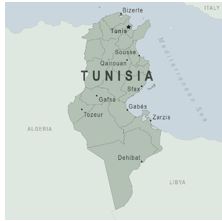

26th July 2022 (6 Topics)
Context
Once regarded as the sole democracy to have emerged from the mass protests of the Arab Spring in 2011, Tunisia is now voting on a newly minted constitution that analysts fear could be the final nail in the coffin of its democratic era.
Background
- Tunisia held a first democratic election in October 2011.
- A new constitution establishing a parliamentary system was agreed in 2014, and Tunisians choose their lawmakers and president in free and fair elections, most recently in 2019.
- However, economic troubles caused hardship and disillusionment. Illegal emigration to Europe increased. The economy, heavily dependent on tourism, was hit particularly hard by COVID-19.
- In July 2021, President Kais Saied froze parliament and sacked the government.
- A year later, Saied called a referendum on a new constitution that strengthened the presidency, capping what his opponents called a march to one-man rule.
- A year later, Saied called a referendum on a new constitution that strengthened the presidency, capping what his opponents called a march to one-man rule.
What was Arab Spring?
- Also called the Jasmine Revolution, it was a campaign of civil resistance.
- It led to the ousting of long-time president Zine El Abidine Ben Ali in 2011.
- It eventually led to a thorough democratisation of the country.
- The effect of Tunisian Revolution spread strongly to five other countries: Libya, Egypt, Yemen, Syria and Bahrain; where either the regime was toppled or major uprisings or social violence took place, including riots, civil wars or insurgencies.
Understanding the crisis
- Yemeni crisis:
- Yemeni Crisis began with the 2011–12 revolution against President Ali Abdullah Saleh, who had led Yemen for more than three decades.
- The opposition groups charged Saleh with financial corruption and criticized him for being backed by Saudi Arabia and United States.
- After a mediated agreement between the Yemeni government and opposition groups, President Saleh left office in 2012, and former vice president, Abdrabbuh Mansur Hadi acquired office.
- However, the new government struggled to unite the fractious political landscape of the country, especially facing threats from the Houthi rebels.
- Changing stance of Houthi rebels: Houthis were initially one among the many oppositions groups against President Saleh, but later in 2014-15, with Saleh’s help, Houthis announced the fall of President Hadi’s government and took control of most northern parts of Yemen. Later Houthis also executed Saleh on charges of treason.
- Houthis in power but not recognised: Since then, Houthi’s are in power and enjoy support. But they have been resisting Saudi-led military intervention in Yemen (with intelligence and logistical support of the US), which doesn’t recognise the Houthi government and seeks to restore previous government to power. Houthis are supported by Iran in their fight against the Saudi coalition.
- This conflict for power between the two factions has led to the on-going Yemeni civil war.
- Recent scenario:
- A U.N.-backed ceasefire took effect in April, 2022 and Hadi, who had spent years in exile in Saudi Arabia, was replaced by a presidential council.
|
Houthi Rebels:
|
- Libya
- In first Benghazi and then Misrata, protests broke out in February, 2011, soon turning to armed revolt against Muammar Gaddafi’s 42-year rule.
- In March 2011, the United Nations Security Council declared a no-fly zone to protect civilians from Gaddafi’s forces and NATO started air strikes to halt their advance on Benghazi.
- By August, rebels had seized Tripoli and in October Gaddafi was captured hiding in a drainpipe outside his hometown of Sirte and killed.
- Local militias seized hold of territory and, as chaos took hold, the country split in 2014 between western and eastern factions.
- The U.N. helped broker a political agreement in 2015, but in practice the country stayed divided and Islamic State seized control of Sirte for more than a year.
- In 2019 eastern commander Khalifa Haftar launched a new war, assaulting Tripoli for 14 months before his forces turned back.
- By now the conflict was international, with Russia, the UAE and Egypt backing Haftar and Turkey the Tripoli government.
- Recent scenario:
- A N.-backed election – part of a peace process aimed at knitting Libya back together was cancelled in December, 2021 for reasons including disputes over the rules.
- In March 2022, the Sirte-based parliament appointed a new prime minister but the government based in Tripoli refused to step down, leaving Libya split between rival administrations.
- Iraqi civil war:
- In 2014 the Iraqi insurgency escalated into a civil war.
- The insurgency was a direct continuation of events following the U.S.-led invasion of Iraq in 2003.
- At the time of insurgency, Iraq was led by a Shia-led government which was constantly under attack by Sunni militant groups who targeted Iraq’s majority Shia population to undermine confidence in the Shia-led government.
|
Yazidis
|
- Syrian civil war:
- The unrest in Syria started as part of a wider wave of the Arab Spring.
- It began in 2011 out of discontent with the Syrian Ba'athist government with protests demanding President Bashar al Assad’s removal; protesters were violently suppressed.
- The on-going conflict in Syria is the second deadliest of the 21st century and widely described as a series of overlapping proxy wars between the regional and world powers, primarily between US and Russia, as well as between Iran and Saudi Arabia. The war is fought between several factions.
- Recent Scenario:
- By the end of the decade, hundreds of thousands were dead and more than half the country’s pre-war population was displaced with the country partitioned between Assad, Turkey-backed rebels and Kurdish-led groups.
More Articles





